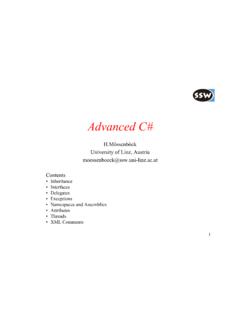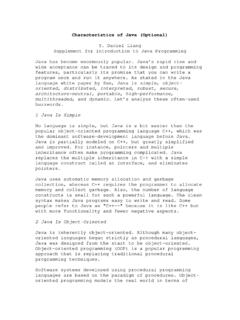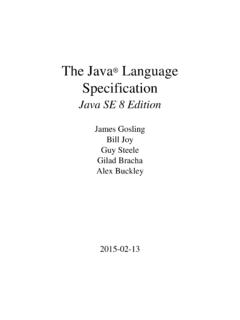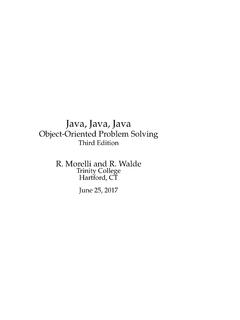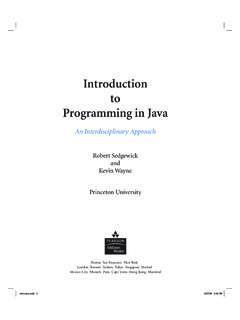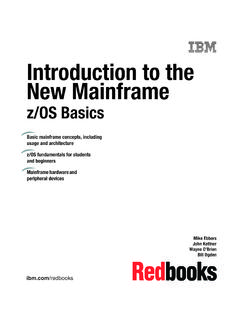Transcription of Introduction to C# - Johannes Kepler University Linz
1 Introduction to C#. The New Language for . ssenb ck University of Linz, Austria Contents Introduction to C# Advanced C#. 1. Overview 7. Inheritance 2. Types 8. Interfaces 3. Expressions 9. Delegates 4. Declarations 10. Exceptions 5. Statements 11. Namespaces and Assemblies 6. Classes and Structs 12. Attributes 13. Threads 14. XML Comments References: , , : C# Essentials. O'Reilly, 2001. et al: Professional C#, Wrox Press, 2001. Online documentation on the .NET SDK CD. 2. Features of C#. Very similar to java 70% java , 10% C++, 5% Visual Basic, 15% new As in java As in C++. Object-orientation (single inheritance) (Operator) Overloading Interfaces Pointer arithmetic in unsafe code Exceptions Some syntactic details Threads Namespaces (like Packages). Strong typing Garbage Collection Reflection Dynamic loading of code .. 3. New Features in C#. Really new (compared to java ) "Syntactic Sugar". Reference and output parameters Component-based programming Objects on the stack (structs) - Properties Rectangular arrays - Events Enumerations Delegates Unified type system Indexers goto Operator overloading Versioning foreach statements Boxing/unboxing Attributes.
2 4. Hello World File using System;. uses the namespace System entry point must be called Main class Hello {. output goes to the console file name and class name static void Main() {. need not be identical ("Hello World");. }. }. Compilation (in the Console window). csc Execution Hello 5. Structure of C# Programs Programm File File File namespace A {..} namespace B {..} namespace C {..}. class X {..} class Y {..} class Z {..}. If no namespace is specified => anonymous default namespace Namespaces may also contain structs, interfaces, delegates and enums Namespace may be "reopened" in other files Simplest case: single class, single file, default namespace 6. A Program Consisting of 2 Files class Counter { Compilation int val = 0;. public void Add (int x) { val = val + x; } csc public int Val () { return val; } => generates }. Execution Prog using System;. class Prog {. Working with DLLs static void Main() {. Counter c = new Counter(); csc /target:library (3); (5); => generates ("val = " + ()).}}
3 } csc / } => generates 7. Types Unified Type System Types Value Types Reference Types Pointers Simple Types Enums Structs Classes Interfaces Arrays Delegates bool sbyte byte float char short ushort double int uint decimal long ulong User-defined Types All types are compatible with object - can be assigned to variables of type object - all operations of type object are applicable to them 9. Value Types versus Reference Types Value Types Reference Types variable contains value reference stored on stack heap initialisation 0, false, '\0' null assignment copies the value copies the reference example int i = 17; string s = "Hello";. int j = i; string s1 = s;. i 17 s Hello j 17 s1. 10. Simple Types Long Form in java Range sbyte byte -128 .. 127. byte --- 0 .. 255. short short -32768 .. 32767. ushort --- 0 .. 65535. int int -2147483648 .. 2147483647. uint --- 0 .. 4294967295. long long -263 .. 263-1. ulong --- 0 .. 264-1. float float .. (32 Bit). double double 5E-324.
4 (64 Bit). decimal --- 1E-28 .. (128 Bit). bool boolean true, false char char Unicode character 11. Compatibility Between Simple Types decimal double float long int short sbyte only with ulong uint ushort byte type cast char 12. Enumerations List of named constants Declaration (directly in a namespace). enum Color {red, blue, green} // values: 0, 1, 2. enum Access {personal=1, group=2, all=4}. enum Access1 : byte {personal=1, group=2, all=4}. Use Color c = ; // enumeration constants must be qualified Access a = | ;. if (( & a) != 0) ("access granted");. 13. Operations on Enumerations Compare if (c == ) .. if (c > && c <= ) .. +, - c = c + 2;. ++, -- c++;. & if ((c & ) == 0) .. | c = c | ;. ~ c = ~ ;. The compiler does not check if the result is a valid enumeration value. Note - Enumerations cannot be assigned to int (except after a type cast). - Enumeration types inherit from object (Equals, ToString, ..). - Class provides operations on enumerations (GetName, Format, GetValues.)
5 14. Arrays One-dimensional Arrays int[] a = new int[3];. int[] b = new int[] {3, 4, 5};. int[] c = {3, 4, 5};. SomeClass[] d = new SomeClass[10]; // Array of references SomeStruct[] e = new SomeStruct[10]; // Array of values (directly in the array). int len = ; // number of elements in a 15. Multidimensional Arrays Jagged (like in java ) a a[0][1]. int[][] a = new int[2][]; a[0]. a[0] = new int[3]; a[1]. a[1] = new int[4];. int x = a[0][1];. int len = ; // 2. len = a[0].Length; // 3. Rectangular (more compact, more efficient access). int[,] a = new int[2, 3]; a a[0, 1]. int x = a[0, 1];. int len = ; // 6. len = (0); // 2. len = (1); // 3. 16. Class Can be used as standard type string string s = "Alfonso";. Note Strings are immutable (use StringBuilder if you want to modify strings). Can be concatenated with +: "Don " + s Can be indexed: s[i]. String length: Strings are reference types => reference semantics in assignments but their values can be compared with == and !
6 = : if (s == "Alfonso") .. Class String defines many useful operations: CompareTo, IndexOf, StartsWith, Substring, .. 17. Structs Declaration struct Point {. public int x, y; // fields public Point (int x, int y) { = x; = y; } // constructor public void MoveTo (int a, int b) { x = a; y = b; } // methods }. Use Point p = new Point(3, 4); // constructor initializes object on the stack (10, 20); // method call 18. Classes Declaration class Rectangle {. Point origin;. public int width, height;. public Rectangle() { origin = new Point(0,0); width = height = 0; }. public Rectangle (Point p, int w, int h) { origin = p; width = w; height = h; }. public void MoveTo (Point p) { origin = p; }. }. Use Rectangle r = new Rectangle(new Point(10, 20), 5, 5);. int area = * ;. (new Point(3, 3));. 19. Differences Between Classes and Structs Classes Structs Reference Types Value Types (objects stored on the heap) (objects stored on the stack). support inheritance no inheritance (all classes are derived from object) (but compatible with object).
7 Can implement interfaces can implement interfaces may have a destructor no destructors allowed 20. Boxing and Unboxing Value types (int, struct, enum) are also compatible with object! Boxing The assignment object obj = 3;. wraps up the value 3 into a heap object obj 3. Unboxing The assignment int x = (int) obj;. unwraps the value again 21. Boxing/Unboxing Allows the implementation of generic container types class Queue {.. public void Enqueue(object x) {..}. public object Dequeue() {..}.. }. This Queue can then be used for reference types and value types Queue q = new Queue();. (new Rectangle());. (3);. Rectangle r = (Rectangle) ();. int x = (int) ();. 22. Expressions Operators and their Priority Primary (x) f(x) a[x] x++ x-- new typeof sizeof checked unchecked Unary + - ~ ! ++x --x (T)x Multiplicative * / %. Additive + - Shift << >>. Relational < > <= >= is as Equality == !=. Logical AND &. Logical XOR ^. Logical OR |. Conditional AND &&. Conditional OR ||.
8 Conditional c?x:y Assignment = += -= *= /= %= <<= >>= &= ^= |=. Operators on the same level are evaluated from left to right 24. Overflow Check Overflow is not checked by default int x = 1000000;. x = x * x; // -727379968, no error Overflow check can be turned on x = checked(x * x); // checked {.. x = x * x; // .. }. Overflow check can also be turned on with a compiler switch csc /checked 25. typeof and sizeof typeof Returns the Type descriptor for a given type (the Type descriptor of an object o can be retrieved with ()). Type t = typeof(int);. ( ); // Int32. sizeof Returns the size of a type in bytes. Can only be applied to value types. Can only be used in an unsafe block (the size of structs may be system dependent). Must be compiled with csc /unsafe unsafe {. (sizeof(int));. (sizeof(MyEnumType));. (sizeof(MyStructType));. }. 26. Declarations Declaration Space The program area to which a declaration belongs Entities can be declared in a .. - namespace: Declaration of classes, interfaces, structs, enums, delegates - class, interface, struct: Declaration of fields, methods, properties, events, indexers.
9 - enum: Declaration of enumeration constants - block: Declaration of local variables Scoping rules - A name must not be declared twice in the same declaration space. - Declarations may occur in arbitrary order. Exception: local variables must be declared before they are used Visibility rules - A name is only visible within its declaration space (local variables are only visible after their point of declaration). - The visibility can be restricted by modifiers (private, protected, ..). 28. Namespaces File: namespace A {.. Classes .. Interfaces .. Structs .. Enums .. Delegates .. namespace B { // full name: .. }. }. File: namespace A {.. namespace B {..}. }. namespace C {..}. Equally named namespaces in different files constitute a single declaration space. Nested namespaces constitute a declaration space on their own. 29. Using Other Namespaces namespace Util { namespace { namespace {. public enum Color {..} public class Rect {..} public class Triangle {.}}}}
10 }. } public class Circle {..} }. }. using ;. class Test {. Rect r; // without qualification (because of using ). Triangle t;. c; // with qualification }. Foreign namespaces must either be imported ( using Util;). or specified in a qualified name ( ). Most programs need the namespace System => using System;. 30. Blocks Various kinds of blocks void foo (int x) { // method block .. local variables .. { // nested block .. local variables .. }. for (int i = 0; ..) { // structured statement block .. local variables .. }. }. Note The declaration space of a block includes the declaration spaces of nested blocks. Formal parameters belong to the declaration space of the method block. The loop variable in a for statement belongs to the block of the for statement. The declaration of a local variable must precede its use. 31. Declaration of Local Variables void foo(int a) {. int b;. if (..) {. int b; // error: b already declared in outer block int c; // ok so far, but wait.
